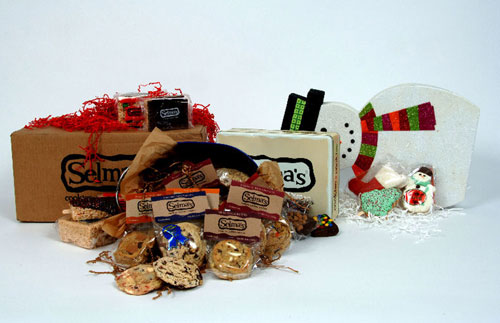

DIABETES AND HOLIDAY FOODS: CEDARS-SINAI PHYSICIAN OFFERS TIPS TO MAINTAIN A HEALTHY HOLIDAY BALANCE Holiday celebrations offer temptation for party-goers to abandon healthy nutrition habits, but calorie-laden festivities pose a special challenge to the more than 20 million Americans who have diabetes. “The key to successfully navigating the holiday season is to remember that even though you can take a holiday, your diabetes never does,” says Philip Barnett, M.D., Ph.D., director of the Anna and Max Webb & Family Diabetes Outpatient Treatment Center at Cedars-Sinai Medical Center. Diabetes, the seventh leading cause of death in the United States, is a metabolic disorder that affects the way the body uses and stores glucose (sugar). During the holidays, people with diabetes should avoid an overabundance of sugary desserts and rich foods and follow a regular exercise routine, says Dr. Barnett, who leads the medical center’s nationally-acclaimed diabetes outpatient program. “People with diabetes can enjoy the wonderful foods of the holiday season--only in moderation. Regular exercise and sensible daily meal planning should be especially important during the next few weeks,” Dr. Barnett says. Dr. Barnett offers the following tips to help people with diabetes enjoy a healthful holiday season:
According to Dr. Barnett, several hundred people in America develop diabetes every day, but an estimated one-third of those affected by the disease go undiagnosed for several years. Symptoms of diabetes include extreme thirst, frequent urination and blurry vision from time to time. Early symptoms of the disease include unexplained weight loss or weight gain, as well as fatigue. Cedars-Sinai has been recognized by the American Diabetes Association with a citation for excellence and ongoing commitment to high quality healthcare for diabetic patients. For more information, please call 310-423-3870. SELMA'S COOKIES
Open up and say ahhhh! Selma's cookies, treats, baskets & more are custom made goodies with only the finest ingredients. Featuring eight flavorful cookies like the award-winning Chocolate Chip Supreme or the Raspberry White Chocolate…your mouth will say thank you! And with so much goodness packed inside, it's hard to believe these full quarter pound cookies are trans-fat free Selma's also makes a great gift for Valentine's, Super Bowl and more with decorated krispy treats and decadent brownies. www.selmas.com Amazing Grass Announces New & Improved Green SuperFood Drink Powder A ‘Whole Food’ Blend of Antioxidant-Rich Fruits & Veggies, Alkalizing Greens, Immunity-Boosting Support Herbs and Digestion-Enhancing Enzymes in a New Economy Size Can Due to busy lifestyles and poor dietary habits, government nutrition experts estimate that only 9% of Americans consume the USDA’s recommended 5-to-9 daily servings of fruits and vegetables. Amazing Grass (www.amazinggrass.com) is a nutrition convenience pioneer that is making it easier to gain powerful whole food nutrition on-the-go with their new and improved Green SuperFood Drink Powder. To obtain healthy servings of fruits vegetables, consumers need to just mix one scoop of the lush green powder with 8 ounces or more of water, juices, smoothies, or other favorite beverages (see smoothie recipe below). The Amazing Grass Green SuperFood blend is a unique and potent combination of nature’s most nourishing, cleansing and rebuilding green superfoods including organic wheat grass, barley grass, alfalfa, spirulina, spinach, chlorella and broccoli. The new formula has been bolstered to feature more than 70% certified organic ingredients and an enhanced digestive enzyme and active probiotic blend to improve nutrient absorption. Amazing Grass has also updated the powder drink mix by adding: Sambazon® Acai - a purple berry loaded with antioxidants, healthy omega fats, fiber and protein that grows in the Amazon Rainforest; and maca - a nutritious root grown at high altitudes in Peru that is known to be an adaptogen that boosts the immune system and provides sustained energy, vitality and mental clarity. Green SuperFood Drink Powder provides more organic whole leaf greens per gram than any leading green superfood mix. It is low calorie and has no added sugar, so it lets people sweeten their beverage on their own or mix it with drinks that have some sweetener already. It is also vegan and gluten-free, and unlike many superfood drink powders, it contains no soy lecithin fillers. Green SuperFood Drink Powder is offered in a new economy size 60-serving canister ($47.99), a 30-serving canister ($27.99), a 15-count box of individual serving packets ($21.99), and a jar of 150 veggie capsules ($27.99). Amazing Grass products are widely available around the country including Whole Foods Markets and Wild Oats, and at www.AmazingGrass.com. The company’s popular GrassHeads program offers auto shipping along with discounts and other promotions. Amazing Grass Green SuperFood powder has a high concentration of naturally-occurring enzymes, carotenoids, phytonutrients and antioxidants that work synergistically to fight free radicals, remove toxins and repair damaged cells. Ultimately, Amazing Grass contains every amino acid, vitamin, and mineral necessary to sustain human life. Since the human body is designed to get nutrition from whole foods, the body is able to efficiently and rapidly absorb the nutrients in Green SuperFood and quickly convert them to fuel. For the majority of people, stress and consumption of unhealthy processed foods can create an acidic imbalance in the blood that, among other problems, can cause the body to store water and build up fat in the arteries (cholesterol) as protection from acidic blood. The rich chlorophyll content and high alkalinity of Amazing Grass Green SuperFood helps to combat acidity and restore blood to the optimal pH level. It also promotes improved circulation, digestion and regular elimination. For more about the specific nutrition science information about Green SuperFood, please visit www.amazinggrass.com. Amazing Grass is a friends and family-owned company with roots that date back over 60 years of growing and dehydrating green foods. The company produces certified organic wheat grass, barley grass, oat grass, rye grass and alfalfa at a family farm in Kansas, and markets the most nutritious, convenient and affordable green superfoods to help families thrive. Amazing Grass stands out because the grasses are field-grown throughout the winter allowing the roots to soak up nutrients from mineral-rich soil for over 6 months. “The young leaves are harvested just one time each year at their nutritional peak,” says President Brandon Bert. The greens are carefully flash dehydrated at low temperatures, frozen as whole leaf powders and then packed in nitrogen to maintain freshness. The extra steps ensure customers get the most nutrient-dense raw green food powders in the world. Amazing Grass’ mission is to educate the world about the benefits of green superfoods and the improved quality of life from healthy eating habits. In addition to the Green Superfood Drink Powder, Amazing Grass offers organic Wheat Grass in drink powder and tablet forms, Green SuperFood Chocolate Drink Powder and Kidz SuperFood Chocolate Drink Powder. For more information, visit www.AmazingGrass.com. 1 banana Blend all ingredients until smooth and drinkable. Contains 2 fruit servings, 3 vegetable servings, 1 dairy serving. HONEY PROVES A BETTER OPTION FOR CHILDHOOD COUGH THAN OTCs Now that the safety and effectiveness of children's cough medicines are in question, what can parents do to help their child deal with a troublesome cough? A new study by a Penn State College of Medicine research team found that honey may offer parents an effective and safe alternative. The study found that a small dose of buckwheat honey given before bedtime provided better relief of nighttime cough and sleep difficulty in children than no treatment or dextromethorphan (DM), a cough suppressant found in many over-the-counter cold medications. Honey did a better job reducing the severity, frequency and bothersome nature of nighttime cough from upper respiratory infection than DM or no treatment. Honey also showed a positive effect on the sleep quality of both the coughing child and the child's parents. DM was not significantly better at alleviating symptoms than no treatment. These findings are especially notable since an FDA advisory board recently recommended that over-the-counter (OTC) cough and cold medicines not be given to children less than 6 years old because of their lack of effectiveness and potential for side effects. The results are published by Penn State College of Medicine researchers, led by Ian Paul, M.D., M.Sc., in this month's Archives of Pediatrics and Adolescent Medicine. In a previous study published in 2004, Paul and colleagues showed that neither DM nor diphenhydramine, another common component of cold medications, performed better than a placebo at reducing nighttime cough or improving sleep quality. However, honey has been used for centuries in some cultures to treat upper respiratory infection symptoms like cough, and is considered to be safe for children over 12 months old. Honey has well-established antioxidant and antimicrobial effects, which could explain its contributions to wound healing. Honey also soothes on contact, which may help explain its effect on cough as suggested by the World Health Organization. In the latest study, the researchers enrolled 105 children between the ages of 2 and 18 at a single university-affiliated physician practice site. On the first night of the study, children received no treatment. Parents answered five questions about their child's cough and sleep quality as well as about their own sleep quality. On the second night, children received either honey, artificial honey-flavored DM or no treatment about a half hour prior to going to bed. Parents answered the same five questions the following morning. The randomized study was partially double-blinded: Medical staff did not know what treatment each participating family received when distributing their sealed syringe-containing envelope. Parents of children who received honey or artificial honey-flavored DM in a measured syringe were blinded to their treatment group. Parents of children in the no treatment group received an empty syringe, and therefore were aware of their child's treatment group. Across the board, parents rated honey as significantly better than DM or no treatment for symptomatic relief of their child's nighttime cough and sleep difficulty. In a few cases, parents did report mild side effects with the honey treatment, such as hyperactivity. "Our study adds to the growing literature questioning the use of DM in children, but it also offers a legitimate and safe alternative for physicians and parents,” said Paul, a pediatrician, researcher and associate professor of pediatrics at Penn State College of Medicine and Penn State Children's Hospital. "Additional studies should certainly be considered, but we hope that medical professionals will consider the positive potential of honey as a treatment given the lack of proven efficacy, expense, and potential for adverse effects associated with the use of DM.” Potentially dangerous effects of DM in young children include dystonic reactions, severe involuntary muscle contractions and spasms. Further, DM is a commonly used as a drug of abuse by adolescents. Cough is the reason for nearly three percent of all outpatient visits in the United States, more than any other symptom. It is particularly bothersome at night because it disrupts sleep. Consumers spend billions of dollars each year on OTC cough and cold medications despite little evidence that these drugs provide significant relief. About Penn State College of Medicine and Penn State Children's Hospital Penn State Children's Hospital is south central Pennsylvania region's only children's hospital. About the grant
|
© 2008 Bonnie Carroll, All Rights Reserved


 EARTH TALK
EARTH TALK